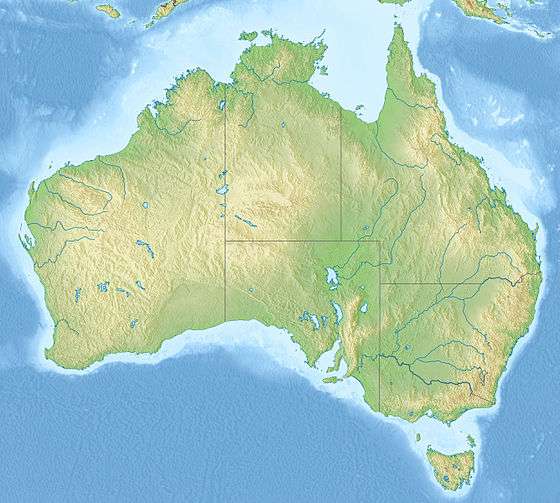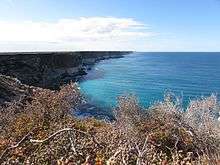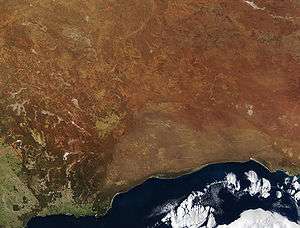Great Australian Bight
The Great Australian Bight is a large oceanic bight, or open bay, off the central and western portions of the southern coastline of mainland Australia.
| Great Australian Bight | |
|---|---|
 Coastline of the Great Australian Bight | |
 Great Australian Bight Location in Australia | |
 Limits of the Great Australian Bight (in red as defined by the International Hydrographic Organization, in green by the Australian Hydrographic Service). | |
| Location | South Australia, Tasmania, Victoria, Western Australia |
| Coordinates | 33°S 130°E[1][2] |
| Type | Oceanic bight |
| Primary outflows | Indian Ocean (in Australia, considered part of the Southern Ocean) |
| Basin countries | Australia |
Extent
Two definitions of the extent are in use – one used by the International Hydrographic Organization (IHO) and the other used by the Australian Hydrographic Service (AHS).
The IHO defines the Great Australian Bight as having the following limits:[3]
On the North. The south coast of the Australian mainland.
On the South. A line joining West Cape Howe (35°08′S 117°37′E) Australia to South West Cape, Tasmania.
On the East. A line from Cape Otway, Victoria to King Island and thence to Cape Grim, the northwest extreme of Tasmania.
The AHS defines the bight with a smaller area, from Cape Pasley, Western Australia, to Cape Carnot, South Australia - a distance of 1,160 kilometres (720 mi).[4][5]
Much of the bight lies due south of the expansive Nullarbor Plain, which straddles South Australia and Western Australia. The Eyre Highway passes close to the cliffs of the bight between the Head of the Bight and Eucla.
Outside of Australia, the Great Australian Bight is generally considered part of the Indian Ocean.[6] The AHS considers it to be part of the Southern Ocean, using the expanded Australian definition used for this ocean.[4] The IHO in its Limits of Oceans and Seas (both the currently in-force 1953 edition[3] and the 2002 never-approved draft) includes the bight with the Indian Ocean, while Bass Strait and the Tasman Sea are included by IHO with the South Pacific Ocean in the 2002 draft. In the 1953 edition, IHO includes Bass Strait as part of the Indian Ocean.
History and exploration
The Great Australian Bight was first encountered by European explorers in 1627 when Dutch navigator François Thijssen sailed along its western margins. The coast was later first accurately charted by the English navigator Matthew Flinders in 1802, during his circumnavigation of the Australian continent. A later land-based survey was accomplished by the English explorer Edward John Eyre.
Natural history

The bight came into existence when Gondwana broke apart and separated Antarctica from Australia around 50 million years ago.[7][8]
The coastline of the Great Australian Bight is characterised by cliff faces (up to 60 metres or 200 feet high), surfing beaches and rock platforms, ideal for whale-watching.[9] This is a popular activity during the southern hemisphere winter, when increasing numbers of southern right whales migrate to the region from their summer feeding grounds in the Antarctic. The whales come to the Bight region, especially to the Head of Bight, to calve and breed, and do not feed until they return to the Antarctic.[10] Their numbers were severely depleted by whaling, particularly during the 19th Century, but have since recovered to some extent.[11]
The Nullarbor Plain, which borders much of the length of the Bight's coastline, is a former seabed, uplifted during the Miocene. Consisting of limestone, it is very flat, and has an arid or semi-arid climate with very little rainfall, and high summer temperatures and high evaporation rates. It has no surface drainage, but has a karst drainage system through cave formation in the underlying limestone. North of the Nullarbor lies the Great Victoria Desert, which has an internal drainage system terminating in numerous small salt lakes.
The lack of surface runoff and terrestrial nutrients results in the relatively shallow waters of the Great Australian Bight being generally low in nutrients, and therefore oligotrophic, compared with many other continental shelves which support major fisheries. Seasonal upwelling of deep ocean water along the coast of the Eyre Peninsula in the eastern part of the Bight brings nutrients to the surface waters, with the resulting fertility creating an important marine hotspot.
The waters of the Great Australian Bight are highly biodiverse, particularly in zooplankton, due to a particular series of ocean currents. A literature review undertaken by SARDI (South Australian Research and Development Institute) on the Benthic Protection Zone of the Great Australian Bight Marine Park in 2003 states: "Upwelling events during summer and autumn produce cool patches of surface water along the coast of the southern Eyre Peninsula. These patches contain elevated nutrient concentrations and support enhanced levels of primary productivity. High densities of zooplankton to the northwest of the patches indicate that the prevailing southeasterly winds transport the products of this enhanced biological production into the central GAB. These plankton communities support the highest densities of small planktivorous fishes, including sardine and anchovy, in Australian waters. Juvenile southern bluefin tuna (SBT) migrate into the GAB annually to feed on these rich pelagic resources."[12] As the nutrients are swept up from the deep water ocean floor and pushed in towards the coast, the food chain is injected with a massive influx of the bottom rung.
There is not enough known about the full scope of species that dwell in or migrate to the Great Australian Bight, so more studies are required. "The Interim Marine and Coastal Regionalisation of Australia (IMCRA) classification suggests that high biodiversity in the GAB may be explained by the presence of temperate species with eastern and western affinities, as well as “tropical stragglers” from northern regions. However, patterns of diversity vary between taxa. Mangroves are poorly represented due to the lack of estuaries. Seagrasses are confined mainly to sheltered bays and the lees of reefs and islands due to the frequent disturbance of inshore habitats by large swells. In contrast, the macroalgal assemblage of the GAB is one of the world's most diverse and includes >1200 species. Over 90% of species in most invertebrate groups are endemic to southern Australia, but the proportion that is confined to the GAB is unknown."[12]
There is still much research needed to fully understand the complex ecosystems of the Great Australian Bight and how any resource extraction or other human activity may affect them. The Literature review also states: "Approximately 370 of the 600 fish species that occur in southern Australia have been recorded in SA. Several species, including the coastal stingaree (Urolophus orarius) and 10 crested threefin (Norfolkia cristata), are restricted to South Australia and occur in the GAB. The patterns of distribution and abundance of fishes in the GAB are poorly understood."[12]
There are some clear findings from the review, "The GAB provides critical habitat for two species of marine mammals that are recognised internationally as being priorities for conservation. The Southern Right Whales (Eubalaena australis), which is listed as ‘endangered’ under the Commonwealth Environment Protection and Biodiversity Conservation Act 1999, breeds at the Head of Bight during winter. The Australian sea lion (Neophoca cinerea), which is endemic to Australia and is currently listed as “near threatened”, breeds in small colonies along the cliffs of the GAB."[12] These marine mammals require this habitat to remain in existence, which has been recognised by Australian law.
One location on the bight that is specifically oriented towards the understanding of the natural history on its coastline is the Eyre Bird Observatory.
Current conditions
Economically, the Bight has been exploited over many years as part of the fishing, whaling and shellfish industries. Southern Bluefin tuna have been a favoured target of fishing in the Bight.
Exploration for oil and gas has been undertaken in the Great Australian Bight region since the late 1960s.[13] There have been recent plans to further explore the Bight by a number of companies, including BP, Statoil/Equinor and Chevron. These proposals were to drill exploration wells in the southern part of the area from 2017 onwards.[14] On 11 October 2016, BP withdrew their plans to explore the area stating that it was not competitive and did not align to their strategic goals.[15] The proposal to explore in the bight has been the focus of community opposition and modelling commissioned by The Wilderness Society showed that a worst-case scenario leak of oil could have a catastrophic effect on the southern coastline of Australia.[16] The Australian Senate commenced an inquiry into Oil or Gas Production in the Great Australian Bight on 22 February 2016. The committee was reestablished on 13 September 2016 following the Australian Federal Election.[17] National Offshore Petroleum Safety and Environmental Management Authority approved exploration plans in late 2019.[18]
The settlements existing along the coastline of the bight, such as Ceduna and Eucla have facilities to access the bight. Some other locations on the Eyre Highway or located on the Nullarbor do not have facilities or easy access.
See also
- Great Australian Bight Marine National Park
- Great Australian Bight Marine Park
- Great Australian Bight Marine Park (2017)
- Great Australian Bight Marine Park (Commonwealth waters)
- Great Australian Bight Marine Park Whale Sanctuary
- Great South Australian Coastal Upwelling System
- Great Southern Reef
- Western Australia - South Australia Border
References
- "Great Australian Bight (WA)". Gazetteer of Australia online. Geoscience Australia, Australian Government.
- "Great Australian Bight (SA)". Gazetteer of Australia online. Geoscience Australia, Australian Government.
- "Limits of Oceans and Seas, 3rd edition" (PDF) (PDF). International Hydrographic Organization. 1953. pp. 35–36. Archived from the original (PDF) on 8 October 2011. Retrieved 18 April 2016.
- "AHS – AA609582" (PDF) (PDF). The Australian Hydrographic Service. 5 July 2012. Retrieved 30 May 2013.
- "Great Australian Bight". Encyclopædia Britannica. Retrieved 29 September 2011.
- "Marine Gazetteer Placedetails". VLIZ. Retrieved 30 May 2013.
- http://rses.anu.edu.au/~brian/PDF-reprints/2012/SN-chapter-2.pdf
- Houseman, Greg. "Dispersal of Gondwanaland". University of Leeds. Retrieved 21 October 2008.
- National Parks South Australia > Whale watching Accessed 12 March 2015.
- Nature’s glory makes a whale of a splash Sunday Mail, 2 August 2014. Accessed 12 March 2015.
- "Conservation Management Plan for the Southern Right Whale - A Recovery Plan under the Environment Protection and Biodiversity Conservation Act 1999 (2011–2021)" (PDF). Retrieved 12 March 2015. Cite journal requires
|journal=(help) - L.J. McLeay; S.J. Sorokin; P.J. Rogers; T.M. Ward (December 2003). "Benthic Protection Zone of the great Australian Bight Marine Park: 1. Literature Review" (PDF). South Australian Research and Development Institute (Aquatic Sciences). ISBN 0 7308 5305 5. Retrieved 12 March 2015.
- "Petroleum Exploration in the Great Australian Bight". South Australia State Development. Archived from the original on 7 November 2016.
- Christoper Russell (28 August 2015). "Oil giant Chevron aiming to begin drilling its first exploration well in the Great Australian Bight in 2017". The Advertiser. Retrieved 26 July 2016.
- "ABC news. BP withdraws from Great Australian Bight drilling". ABC.
- Oliver Milman (9 October 2015). "BP oil spill in Great Australian Bight would be catastrophic, modelling shows". The Guardian. Retrieved 26 July 2016.
- "Oil or Gas Production in the Great Australian Bight - Senate Committee".
- https://docs.nopsema.gov.au/A705648. Missing or empty
|title=(help)
Further reading
- Edminds, Jack (1976) Panorama of Western Australia : the Great Australian Bight Perth,W.A. Periodicals Division, West Australian Newspapers. ISBN 0-909699-11-9 (ANB/PRECIS SIN 0140147)
External links
- Great Australian Bight Marine Park - Eyre Peninsula- the South Australian portion of the park
- Great Australian Bight Trawl Fishery
- Wild Down Under Great Australian Bight- BBC Nature Documentary webpage for the fauna of the region
- aerial video of the Great Australian Bight
